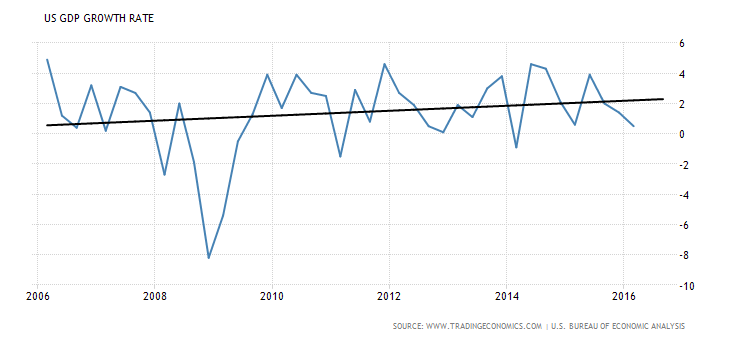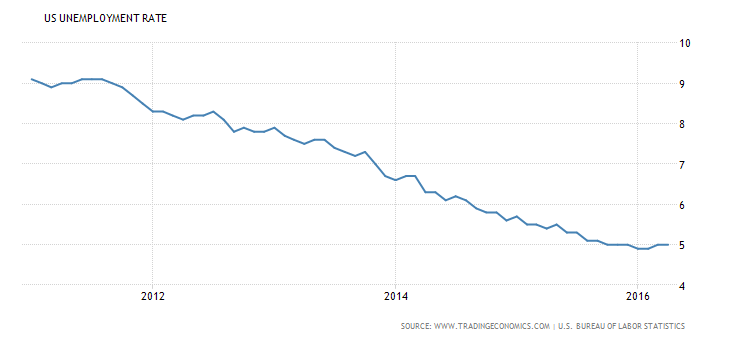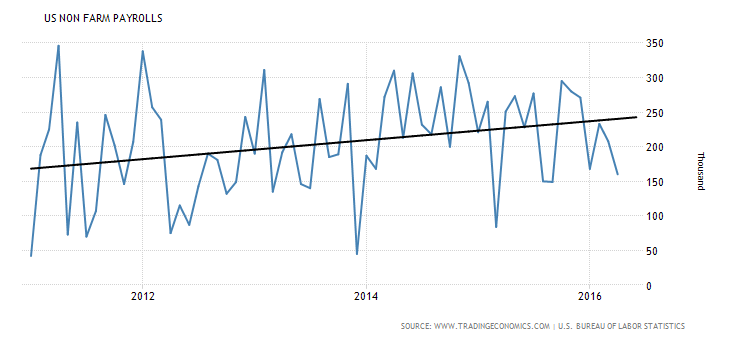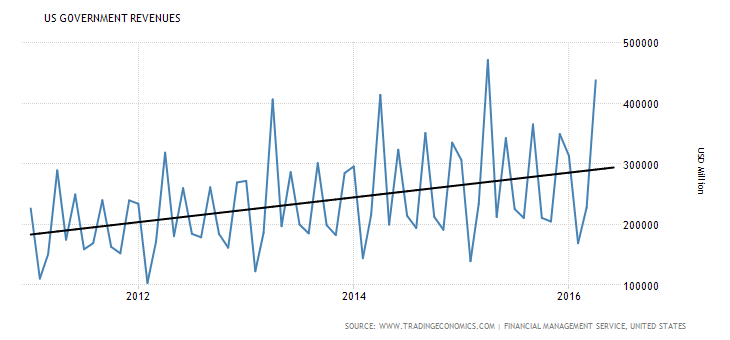The release of the latest FOMC minutes has once again kicked the hornet’s nest that is the world of market commentators. Following the release, the market rallied to the greenback and analysts drew battle lines to argue just how mad they thought the Fed was in considering a rate hike.
Some argue that the Fed is simply hammering the expectations channel and has no real agenda to hike rates. In contrast, others believe that a hike remains a real possibility and the Fed is simply denying what is ostensibly a new recession.
However, could a rate hike not only be a possibility but a reasonable response from the Central Bank? Taking a look at some of the data could, at least, give an insight into exactly what is going through the FOMC’s heads.

Central to the decision to change rates is the national GDP, consequently, looking at historical US GDP growth and future prospective growth remains key. Whilst recent figures show that US GDP only grew by 0.5% in Q1 2016, generally speaking, US GDP growth has been trending up for some time.
As shown below, despite oscillating rather widely, the US is having a slight uptrend in results and the current lows could simply be a result of the normal business cycle. Of course, typically Q1 is the best performing quarter for GDP growth but this is by no means a hard and fast rule. Consequently, strong subsequent quarters could see yearly GDP growth exceed 2%.

Whilst GDP is an important indicator of general US economic health, the Fed is primarily concerned with its dual mandate in which it attempts to balance inflation and unemployment. For all the doom and gloom often spouted by analysts, the fact remains that there is some quantifiable improvement in the US economy. Specifically, unemployment has been steadily on the decline from almost 7% in 2014 to just 5% in the latest figures.
Additionally, US non-farm payrolls have been steadily improving for quite some time. The improvement is easy to miss given the rather large oscillations that are typical of the indicator. As a result of strengthening employment data, it is little wonder the Fed might see itself as having some wiggle room to flirt with the possibility of a rate hike.

As the employment component of the Fed’s dual mandate is being met, recent upticks in inflation could likewise allow for a rate hike. As shown on the below graph, the inflation rate has been steadily improving since 2015 and could probably weather the hit which would result from a hike.
What’s more, it’s important to remember the often forgotten aim of the Federal Reserve which is to keep interest rates moderate in the long-term. Consequently, if inflation and employment allows for it, an increase in interest rates from the historically low 0.5% is actually a mandated component of the Fed’s monetary policy.

Cooling of the US economy by increasing interest rates is a sure-fire way to stifle GDP growth which, at this juncture, the Fed is loath to do. Because of this, there is a healthy amount of scepticism circulating questioning the actual likelihood of the Fed hiking rates.
However, whereas monetary policy could suppress US growth, it looks as though US fiscal policy is picking up the slack. Specifically, government spending has increased consistently since 2014 to the tune of around USD50 Billion.
If spending continues to increase, the US could help to combat contractionary pressures as the public sector pumps money into the US economy. This of course begs the question, can the US really afford to pursue expansionary fiscal policy and balance out the effect of a hawkish Federal Reserve?
Looking at US government revenue figures shows that not only are revenues increasing in the long run but recent numbers are near historic highs. As a result, there remains a strong chance that the US could continue using fiscal policy to prop up the economy in the event of a rate hike.

After looking at some of the basic evidence, the case to increase interest rates may not be a wildly out of place as it initially seems. Given decreasing unemployment and greater inflation, the Fed conceivably has the requisite manoeuvring room to push rates higher. Additionally, if fiscal policy is in place to mitigate depressionary effects on GDP growth, the Fed may have the blank cheque it needs to hike in the next FOMC meeting.
Whether the Fed is right or wrong in increasing rates will only be revealed by time. However, currently the data in no way expressly precludes a hike. Consequently, when the next rate decision comes around,it would not be a total surprise if the Reserve isn’t all talk this time.
